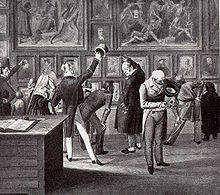
Hans Holbein the Younger was a German-Swiss painter and printmaker who worked in a Northern Renaissance style, and is considered one of the greatest portraitists of the 16th century. He also produced religious art, satire, and Reformation propaganda, and he made a significant contribution to the history of book design. He is called "the Younger" to distinguish him from his father Hans Holbein the Elder, an accomplished painter of the Late Gothic school.

Johannes Oporinus was a humanist printer in Basel.
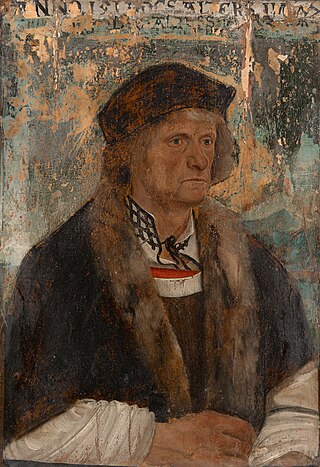
Johann Amerbach was a celebrated printer in Basel in the 15th century. He was the first printer in Basel to use the Roman type instead of Gothic and Italian and spared no expense in his art.

Johann Froben, in Latin: Johannes Frobenius, was a famous printer, publisher and learned Renaissance humanist in Basel. He was a close friend of Erasmus and cooperated closely with Hans Holbein the Younger. He made Basel one of the world's leading centres of the book trade. He passed his printing business on to his son, Hieronymus, and grandson, Ambrosius Frobenius.

The Kunstmuseum Basel houses the oldest public art collection in the world and is generally considered to be the most important museum of art in Switzerland. It is listed as a Swiss heritage site of national significance.
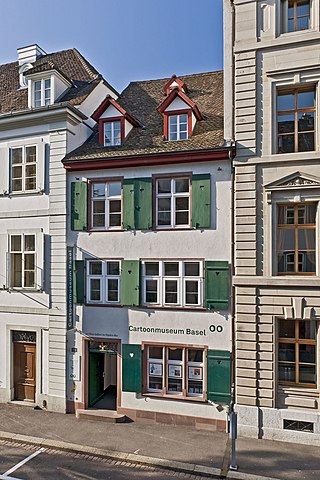
Cartoonmuseum Basel is the only museum and centre of excellence in Switzerland devoted exclusively to the art of narrative drawing, be it in comics, graphic novels, comics reportage, cartoons, satirical drawings or animated films. It collects individual works, curates exhibitions and shares knowledge about the genre. The museum contributes to the debate about the art of narrative drawing, and about the social and political issues it addresses.

Johann Rudolf Wettstein was a Swiss diplomat and mayor of Basel, who achieved fame through his diplomatic skills, culminating in Swiss independence from the Holy Roman Empire in 1648.
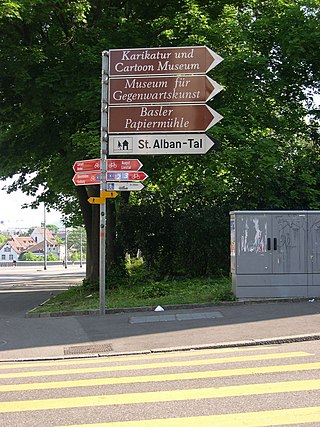
The Basel museums encompass a series of museums in the city of Basel, Switzerland, and the neighboring region. They represent a broad spectrum of collections with a marked concentration in the fine arts and house numerous holdings of international significance. With at least three dozen institutions, not including the local history collections in the surrounding communities, the region offers an extraordinarily high density of museums compared to other metropolitan areas of similar size. They draw some one and a half million visitors annually.

The Body of the Dead Christ in the Tomb is an oil and tempera on limewood painting created by the German artist and printmaker Hans Holbein the Younger between 1520 and 1522.

Lais of Corinth by Hans Holbein the Younger portrays the famous Lais of Corinth, a courtesan of ancient Greece who charged a high price for her favours. It has been suggested that Holbein is also referring to the Lais who was the lover of Apelles, the great painter of antiquity. The model, the same used for the Venus and Amor, has been identified as either Magdalena Offenburg or her daughter Dorothea, as it was noted by Basilius Amerbach in the archives from the Amerbach-Cabinet, that the woman depicted was someone of the Offenburg family. Dorothea would have been eighteen years of age in 1526. It was assumed that either of the two may have been Holbein's mistress. Both paintings, the Venus as the Lais, came into the possession of the Amerbach Cabinet in the late 1500s.

Hans Holbein the Younger painted the Portrait of Erasmus of Rotterdam several times, and his paintings were much copied, at the time and later. It is difficult to disentangle Holbein's original work from that of his workshop and other copyists. Possibly five largely original versions survive, as well as a number of drawings made as studies.

Basilius Amerbach was a lawyer, professor and collector from Basel. He was the only son of Bonifacius Amerbach.
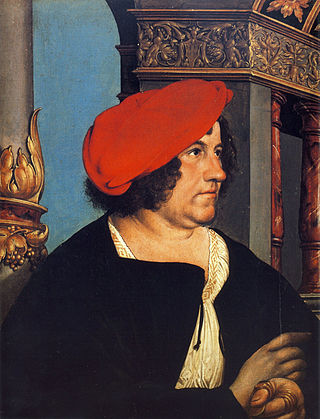
The Double Portrait of Jakob Meyer zum Hasen and Dorothea Kannengießer is a 1516 oil-on-limewood panel painting by Hans Holbein the Younger. The two panels were commissioned by Jakob Meyer zum Hasen, mayor of Basel, and show him and his second wife Dorothea Kannengießer. The occasion for the portrait could be Meyer zum Hasen's election as the mayor the same year. Holbein was eighteen years old at the time and had arrived in Basel together with his brother Ambrosius only in 1515. He signed with the letters HH. He received the right to sign with his full name in 1519, when he was accepted as a member of the painters' guild of Basel.

Von der Mühll or Von der Mühl is a Swiss patrician and noble family.
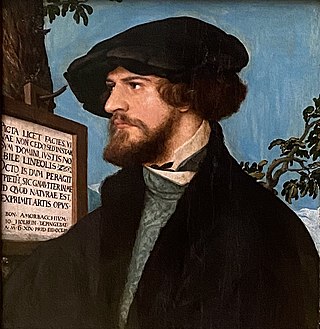
Bonifacius Amerbach was a jurist, scholar, an influential humanist and the rector of the University of Basel for several terms.

The Portrait of Bonifacius Amerbach is a painting by the German master of the Renaissance Hans Holbein the Younger. It is deposited in the Basler Kunstmuseum as part of the Amerbach Cabinet. It is painted in mixed technique on pine panel and measures 29.9 cm x 28.3 cm.

Remigius Faesch. was a Swiss jurist and rector of the University of Basel.

Portrait of the Artist's Family is a portrait of the family of the painter Hans Holbein the Younger by the artist himself. It depicts Holbein's wife Elsbeth Binzenstock, their son Philipp and their daughter Katharina. Holbein painted it during his stay in Basel after his return from England. It was painted, between 1528 and 1529, on paper and glued on wood.

Niklaus Stoecklin was a Swiss painter and graphic artist. He is regarded as a Swiss exponent of New Objectivity and Magic Realism, and at least with his early works numbers among their international co-founders. He was also a poster designer of international renown.
